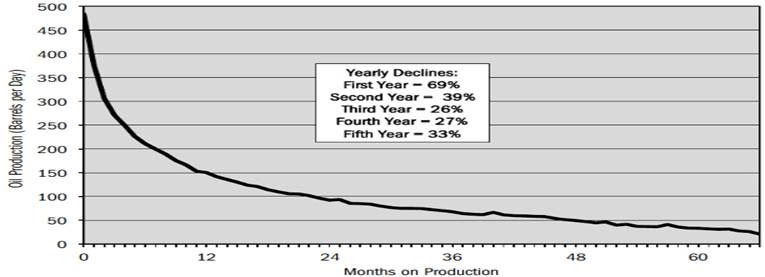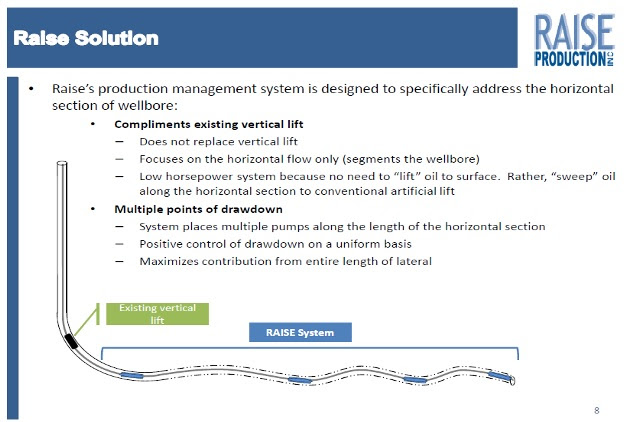A New Industry Was Born Today--and so far it's a Monopoly
By – Published in on April 11, 2014

There is a multi-billion dollar problem in the oil patch just looking for a solution—get oil to flow better along the horizontal leg of a well.
A small Canadian company called Raise Production Inc. (RPC-TSXv; GLKFF-PINK) thinks it may have the answer.
They have developed a way to place many small motors down the horizontal leg of a well bore and have them fire in parallel—that means right after each along the well—creating multiple draw down points for oil to be hurried along the well to the vertical part of the well bore.
This beta technology is not yet commercial, but on April 10 they announced their first test well increased production by 300%, and the stock has moved 100% today—a double. The Market believes it will work.
They’ve created an entire new industry—horizontal leg engineering. There is reservoir engineering, and now this. This management team had an idea that oil reservoirs are all very different, and should not decline at the same rate. They assumed that the reason most decline rates are so similar is because of a mechanical issue in the horizontal leg.
And they believed they could fix that. Their little motor system appears does that.
The potential is enormous. Over the next three to five years there will be 26,000 horizontal oil wells drilled in the United States alone just to meet the drilling requirements of land leases.
In the five years that follow that, the energy industry is still going to be making “swiss cheese” of the North American landscape drilling thousands of wells.
There are billions and billions of barrels in the ground in these horizontal plays that we still can’t get at with the current methods of horizontal drilling.
Five years ago this horizontal drilling revolution was barely on anyone’s radar. Today millions and millions of barrels of oil are being produced from horizontal wells.
Precipitous Decline Curves – The Curse Of Horizontal Oil Production
At this point everyone knows about the horizontal oil boom that has transformed North American oil production. But North American horizontal oil wells today likely needs an oil price of $85 or higher to generate any positive return.
What makes these horizontal oil wells require such high oil prices is their production profile. The current nature of a horizontal oil well is an initial surge of “flush” production. That flush production is followed by a first year decline curve that is incredibly steep.

The major horizontal oil fields in Canada and the United States all have similarly high rates of first year declines:

Every one of the major oil fields in North America loses more than half of their initial rate of production after just one year.
Compare that to a vertical oil well that is drilled into a conventional reservoir. Those wells decline at much slower rates which allows for much stronger cash flow for a longer period of time.
The solution proposed by Raise Production could turn the decline curve of a horizontal well into something that looks more like a conventional vertical well.
Any decrease in the rate of decline would increase the return on capital invested drilling a well. It would mean that every single horizontal well that is drilled going forward using this technology would make more money for the driller than it would without it.
Such a significant increase in the rate of decline would mean tens of billions of dollars of value to the energy industry.
Therefore, a patented solution that significantly changes the decline curve on horizontal oil production would also be worth billions.
Raise Production Inc’s Novel Production Management System
Raise Production believes that problem with horizontal wells that creates the steep declines is the lack of flow management. A horizontal well goes straight down vertically and, over quite a distance, turns at a right angle and continues straight sideways.
Raise Production’s technology aims move oil along the horizontal section of the well much better to the vertical section where it is “lifted” to the surface.

According Raise Production current horizontal wells suffer from the following:
- Isolation of the oil at the toe (the far end) of the horizontal well
- An increase in gas to oil ratios
- Inefficient mobilization of fluids
Raise Production’s patented technology addresses these challenges.
The Raise Production system is designed to go to work in the horizontal section of the wellbore. The system places multiple pumps along the horizontal section of the well.
The system “sweeps” the oil along the horizontal section of the well and toward the vertical section. This helps the oil reach a point where the normal artificial lift in the vertical portion of the well can influence the flow of oil to the surface.
The result of all of this should be that more oil gets to the vertical section of the well, and oil that would have eventually gotten there on its own arrives faster.
More oil sooner equals higher profit per well and higher rates of production.
First Field Testing Is Complete
Raise Production has spent two and a half years and lots of blood, sweat and tears developing the system.
The company has gone from the conceptual design phase, to industry focus groups, to detailed design, to securing patent protection and finally construction of a proto-type.
All of that work culminated last August with the deployment of the first proto-type system into the field.
On October 21 of last year Raise announced the completion of that initial 60 day field test.
The company was pleased with the results which indicated that the system worked as designed, is stable and that it can have a meaningful impact on horizontal flow.
Raise also announced that through the testing some additional things were learned that can lead to improvements in the system and additional patents.
Based on the results of this field test Raise and its industry partner agreed to try a second deployment of the system at the end of November on the same wellbore.
Those next set of test results were announced last night from a well in the Viking play in Saskatchewan—and showed increases in well bore production of 300%
If this second field test also yields positive results Raise intends to roll out a commercial version of the system in the Viking light oil play in 2014.
The potential is huge, but it’s early, early days. But the Market believes.
DISCLOSURE--I do not own this stock.
PS--Global Cooling Part III is coming Monday!
PPS--The OGIB rate increase happens on April 23--beat the rush and save money! http://oilandgas-investments.com/subscribe-here/

Comments